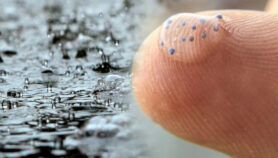Send to a friend
The details you provide on this page will not be used to send unsolicited email, and will not be sold to a 3rd party. See privacy policy.
Antibiotic ‘could help prevent brain fever’
A common antibiotic could help prevent Japanese encephalitis, also known as brain fever, in children. Studies by researchers at the National Brain Research Centre near Delhi, India, show that minocycline, a second-generation tetracycline, helps reduce the death of nerve cells and replication of the virus. The authors, writing in the Journal of Neurochemistry, say the drug is worth considering for clinical trials. More>>
Pakistan institute announces new genetic projects
Pakistan’s National Institute for Biotechnology and Genetic Engineering plans to undertake 11 new research projects. The projects include research on salt tolerance in wheat and the promotion of rhizobacteria in leguminous plants. More>>
Sri Lankan waters ‘highly polluted’
The waters around Sri Lanka are among the most heavily polluted in the world, according to a team of British and Canadian and US scientists. Their research, published in Science, is based on a survey of 17 human activities that impact oceans. The area around Sri Lanka ranks among the most affected areas. More>>
Activated charcoal no help to pesticide poisoning
Using multiple doses of activated charcoal does not prevent death in cases of self-poisoning. A study in Sri Lanka, reported in the Lancet, shows that activated charcoal treatment cannot be recommended for the Asia Pacific region. The rate of suicides mostly using pesticide poisoning, are 10–50 times higher in rural areas of developing countries compared to industrialised countries. More>>*
Insulin resistance gives clue to Indian diabetes rates
Researchers at the Mayo Clinic in the United States have found high levels of insulin resistance in urban Indians, offering some clue to their higher diabetes incidence — the highest in the world, estimated at 32 million and projected to double over the next 30 years. More>>
India, Canada to collaborate on bioenergy
The Indian Council of Agricultural Research and Canada’s Saskatchewan University will work together on research into producing energy from biomass crops and feedstocks. The joint bioenergy research will focus on biodiesel, bioethanol and biohydrogen, and include the use of ultrasound, gasification and anaerobic digestion technologies to produce bioenergy. More>>
Scientists find how virus mutates, adapts
Research reported in Virology Journal shows how a single gene mutation helps the chikungunya virus adapt rapidly to new mosquito hosts and environments. Since 2004, several million chikungunya cases have occurred in Africa, Asia, India, Europe and the Indian Ocean Islands. More>> ![]() [485kB]
[485kB]
Messenger molecule ‘plays key role in leishmanaisis’
Scientists have discovered more about how Leishmania donovani, the parasite that causes leishmaniasis, or kala-azar, manages to resist damage in a host to become more infective. Indian scientists, reporting in Free Radical Biology and Medicine, are the first to show a key role for a molecule that acts as a messenger in sending signals across cells. More>>
Crop waste ‘mops up metallic wastes’
Crop residues are efficient absorbers of metallic wastes in industrial waters. In a review in Bioresources Technology, Indian scientists say crop waste is a cheap, renewable source of biomass that can be exploited and scaled up for use in cleaning up industrial waste. More>>
New technique discovered to create iron ceramics
A combination of two techniques helps produce industrially important ferrites — iron-containing ceramic compounds that act as magnets. Ferrites — used in electronic inductors, transformers and electromagnets — contain a mix of metal alloys. The new method, developed by chemists from the Indian Institute of Technology, Kanpur, and reported in Current Science, first produces the metals at the nanoscale by reducing their salts, and then joins them using ultrasound waves. More>> ![]()
![]()
![]()
![]()
![]()
*Free registration is required to view this article.













